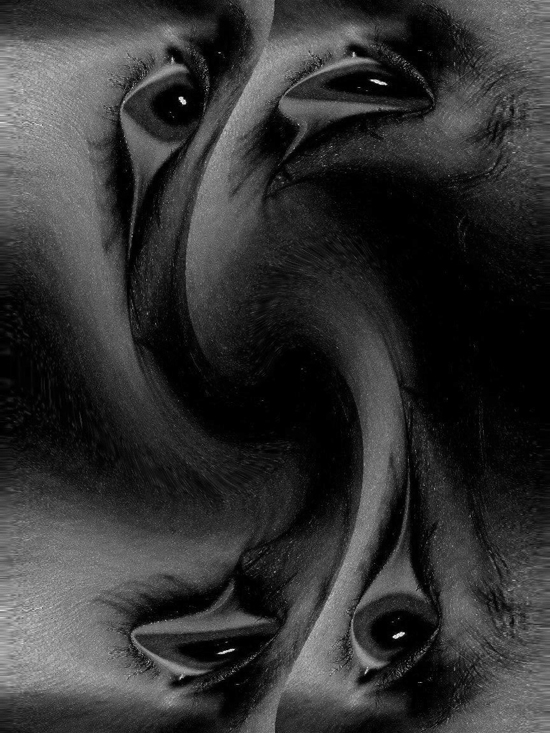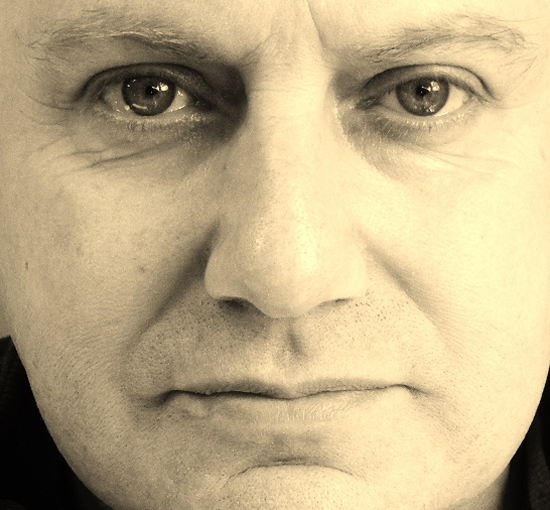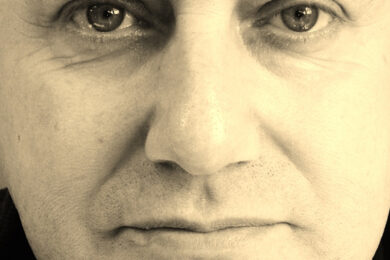The career of Steve Parry, classically trained guitarist and composer, spans nearly three decades, encompassing threads that reach back as far as the post-punk movement and as far forward as the contemporary prevailing drone/doom scene.
His long running project Hwyl Nofio loosely translates as "emotional swimmers", and each work under that name is resolutely individual, producing such remarkable results as 2002’s Hymnal, an evocative treatise on religious symbolism, 2006’s Hounded by Fury, a mordant collection of stark instrumentals, and the arresting guitar tonality of Parry and Søegaard’s joint release Off the Map (2007). Parry defines Hwyl Nofio as "cathartic, in the sense that it is based on personal understanding of an explicit time and place", and each release bears the weight of pure emotion and expression.
The latest album from Hwyl Nofio is entitled DARK, and dares to occupy a space beyond the temporal and the spatial. Instead it explores a landscape steeped in Parry’s own personal experience, inspired by walking through his home region of South Wales with a camera and field recorder in hand. Parry provides tangible evidence of this landscape in an accompanying book that introduces the listener to a world of chilling folk myths and the resonances of his own family histories, as well as timely references to the forgotten legacies of local artists/writers Jane Arden and Bruce Chatwin. Their extraordinary work, commemorated in the tracks ‘Anti-Clock’ and ‘On the Black Hill’ respectively, acts as markers for the road less travelled, indicating divergent routes throughout the album that lead to ever more surprising vantage points.
DARK‘s alien, minimalist fields of sound contain symbols that are disorienting in their familiarity, and the album’s sensory impact resides in the intrigue of the ordinary. In its midst, you are without compass, but are also without fear. Its intimacy swallows you whole. The Quietus caught up with Parry to discuss his musical history and the inspirations behind this new album.
What are the origins of DARK?
Steve Parry: I had spent a considerable amount of time committed to recording a project called Wern. Wern effectively had become the next Hwyl Nofio album after Hounded by Fury. The music had been written and recorded, a tracklisting finalised, the CD booklet designed, featuring a front cover with a haunting image taken at a religious festival in Madrid, Spain – everything had progressed well, so it appeared all systems go. Then, quite literally, following time spent with my wife Julia at home in South Wales, I had a complete change of mind and pulled the plug on the album.
I had been concurrently working on a book about my mother Annie. I’m of an age where the stories she’d told me as a child resonate through the years. My mother is a natural born storyteller, she comes from a large family; her father had been a coal miner, she had two elder brothers who also were miners, they sounded an interesting lot – tough times during a depression hit industrial South Wales, hard as nails, fighters, people you didn’t really mess with. The book I’d compiled and published as a personal memoir – a memento for future generations. I wanted the kids to know about their past, their pedigree – family to me matters. I’m sure my two year old grandson Owen will one day find some connection or fascination with the old story.
It’s bizarre how family, home and landscape retain a hold over you! I needed to move away to appreciate this question. The allure of being in South Wales remains to this day. I suppose in many ways I never left. Some might say its sentimental crap – a distant image corrupted by time. I’ve spent the last thirty-plus years of my life living in Yorkshire. However, I need a regular Welsh fix, and so returned to Pontypool and the eastern valley, the place I was born. Camera and audio recorder at hand, we stayed in a small stone cottage on Coity Mountain, walked and played in the surrounding landscape. You immediately become immersed by a sense of what has gone before. With a natural backdrop of mountains and rivers, industrial relics literally emerge from the earth like corpses from a grave. A strange beauty prevails out of the damage of the place – a wonderful optimism resides in the people when all around appears dead or buried.
On my travels I tend to pick up local pamphlets, books, and visit museums. I discovered the very cottage we were staying in had once belonged to my family. Having visited the local chapel, I discovered a graveyard full of dead relatives. We had lived and died in the valley over a period of many hundreds of years.
Out of a deluge of information I started thinking about the notion of DARK.
‘Old Crow’, taken from the DARK album
How do you go about making music as Hwyl Nofio? What are your working processes?
SP: I think of music in a sort of painterly way. It’s a cathartic process where emotions correlate with sounds. Music is subjective, reactive, in a constructionist way it’s a way of me working things out as sound. I’m fascinated by the mechanism of sound, from a cognitive angle – why certain sounds influence emotion/behaviour. It all sounds pretty heavy but it’s a perfectly ordinary thing. I don’t sit there drawing diagrams or developing methodology. It happens – fuck, it just happens! When I started learning classical guitar at the age of eight my parents bought me this huge guitar strung with steel strings. The bloody thing was so warped, having been overstrung by a previous owner, playing the thing was torture, the strings lacerating my young fingers. I would borrow a guitar from the tutor for the lesson, but had the impossible task of practicing on the warped guitar at home. Not able to connect with the instrument in a traditional sense, I soon became fascinated by the possibilities of creating sound from a broken instrument.
I’d put bits of metal (Meccano) between the frets, paperclips, pieces of Hornby railway track, and other foreign bodies inside and on the guitar. Hence the frustration derived from not being able to play the guitar created pleasure in terms of the possibility of creating all these strange unorthodox sounds. I started piano lessons at the age of eight – again, being a brilliant piano player didn’t appeal to me. I loved lifting the piano lid and tampering with the metalwork within. An early recording featured me playing the piano whereby crisp packets had been placed between the hammer and the strings. Aural bliss!
During my time at senior school I did play guitar in a traditional sense in an old gentleman’s jazz band. I suppose I’m a musician/non musician – I can play, but I choose not to, preferring to experiment with the guitar as sound source, a means of creating sounds. I dislike going into music shops to witness an anonymous guitarist strut their stuff – soloing endlessly, seemingly mindlessly titillating the ego. I do own and play conventional guitars, but guitar histrionics is categorically not for me. I do admire great technicians like Jimi Hendrix or composer, improvisers such as Fred Frith and Derek Bailey. I have a soft spot for the poetic exquisiteness of the playing of Bill Nelson, whose boundless creative harvest is inspirational. Bill & his wife Emiko live nearby, and have become old friends.
Hwyl Nofio is basically me, but each project has comprised of other likeminded individuals. They are musicians whom I have come to know and respect, people I enjoy working with. I came to the work of guitarist Sandor Szabo via a mutual friend, musician Gilbert Isbin. Sandor is a passionate Hungarian composer and technically brilliant avant guitar player who brings improvisation and experimentation. Fredrik Søegaard is a gracious human being and most extraordinary musician who experiments with sounds and plays fractal guitar. Mark Beazley is someone I have known for over 10 years. He fronted a group called Rothko, an ambient group consisting of bass guitars and keyboards. Trevor Stainsby, again is a friend and collaborator. Gorwel Owen, whom I have known for many years, is a record producer and purveyor of abstract banjo sounds.
Creating music as Hwyl Nofio is about bringing different elements together. The overall conceptions and sounds are primarily mine, then I look to the other musicians to compliment the proceedings. Trevor Stainsby had formerly contributed considerably to Hwyl Nofio by recording and playing on earlier releases. Likewise, Mark Beasley played bass and was involved in the mastering and co-production on the latest album DARK. I think the essence of Hwyl Nofio is about respect and understanding.
feature continues below image

What are the specific influences that inspired and/or enabled you to create the album?
SP: DARK personifies a diverse myriad of influences. I suppose ultimately it’s about self and the question of whom or what we are as people. It’s not easy to be specific about influences, I suppose it’s about relatedness and feelings that enter consciousness and manifest in us being compelled to create something from it.
I recall as a boy sitting on the mountain listening to the sound of an endless stream of coal trucks rattle their way through the valley. The thud from beneath the earth of explosives shattering the coal reverberates through the body. The intense white light heat and deafening noise of the steelworks, laying on my back on a hot summer day watching a bird of prey circle endlessly and ominously high in the sky, the sound of a lone church bell chime in the distance.
I had heard numerous tales about the wonderfully eccentric Rev Edmond Jones. Edmund Jones is the source of much of our knowledge of the landscape, way of life, customs and folklore of Blaenau Gwent before the Industrial Revolution altered the valleys forever. The house in which Edmund Jones resided is called Lower Pen-tranch and had since been home to members of my family. He was known in Monmouthshire as yr Hen Broffwyd (‘the Old Prophet’), because of deep interest in astrology and his seemingly genuine gift of prophecy. His books contain a collection of the most extraordinary apparitions, to all of which are assigned a divine or diabolical origin. He was noted in the district for foretelling things and presided over a Fairy-folk funeral at the same aforementioned chapel in which family are buried.
I am an admirer of Surrealism and other forms of abstract art. The cinema of Luis Buñuel, especially his early films made with Salvador Dali – Un Chien Andalou (1928), with a perpetually shocking opening shot of the eye being sliced by a razor, and L’Âge D’or (1929), a sacrilegious mix of quasi-scientific documentary, psychoanalytic symbolism and eye-catching visual imagery. In 1929 Man Ray created Les Mystères du Château de Dé with Duchamp and L’Étoile de mer, centred on a poem by Desnos, relying on improvisation to produce a kind of ‘automatic cinema’.
The surrealist film director, actor and poet Jane Arden had lived literally lived a street away from where my mother lived. Arden is a brilliant, complex individual whose work I stumbled on by accident really, intrigued by the abstract/experimental nature of her films and the fact we both originate from the same town – I needed to learn more. Arden was an actress, author, filmmaker and poet whose screenwriting and directorial work of the late ’60s and ’70s explored themes of social isolation and ‘madness’, sexual politics and radical feminism. For her last film, Anti-Clock (1979) Arden also wrote and performed the soundtrack. It’s a complex and fascinating experimental exploration of time and identity, and remains a film of genuine, startling originality utilising both cinema and video techniques. DARK features an original composition called ‘Anti-Clock’ as homage to the work of Jane Arden. If you haven’t seen her films, go check them out!
I also am an admirer of the work of the photographer Angus McBean. McBean was born in Newbridge, Monmouthshire. The son of a coal mine surveyor, he purchased his first camera – a 2 1/2 x 3 1/2 inch autographic Kodak – and tripod as World War I was ending. Fascinated by the apparently magical properties of photography he plied his trade as a theatrical photographer, constructing elaborate stages and props that portrayed surreal images of famous subjects, who included Vivien Leigh and Laurence Olivier. McBean’s photographs are both abstract and mystical.
On the Black Hill is a novel by Bruce Chatwin published in 1982. It portrays themes such as unrequited love, sexual repression and confusion, social, religious and cultural repression, hate and the historic social values of that era. The story is told through the technique of flashback, and portrays the lives of twin brothers, Lewis and Benjamin Jones, living on a remote upland farm called The Vision. The sleeve image for the Hwyl Nofio album Hymnal was taken in an isolated church in the Gospel Pass – frontier land, bordering the Black Hill.
All of the above, along with rebellion, Chartist riots, bare knuckle boxing and the odd murder, inform DARK.
Do you view the track titles as signifiers of a specific setting or environment?
SP: Yes, that’s pretty much always been the case. For instance, ‘Jerusalem Lane’ from the Hwyl Nofio album The Singers and Harp Players are Dumb, is an actual place. The composition is based around mortality and witnessing my own funeral! The composition ‘From Elevated Gangways Rivers of Molten Metal Flow’ is founded on visiting a local steelworks. ‘Herbert the Steel-roller’ from DARK is about Herbert Parry, my grandfather, who worked as a steel-roller at Panteg Steelworks.
What are you working on at the moment?
I’m always working on new Hwyl Nofio. I’m currently planning and working on a joint production with Mark Beazley, I’ve this German motorik/dub type music with classical overtones in mind, plus some contemporary ballet music with an old partner in crime – avant saxophonist Steve James Sherlock. I may release Elevated Gangways and Christ Distort together on a CD (both previously had been available as very limited editions).
Hwyl Nofio’s DARK is out now. For more information, click here to visit his website.




